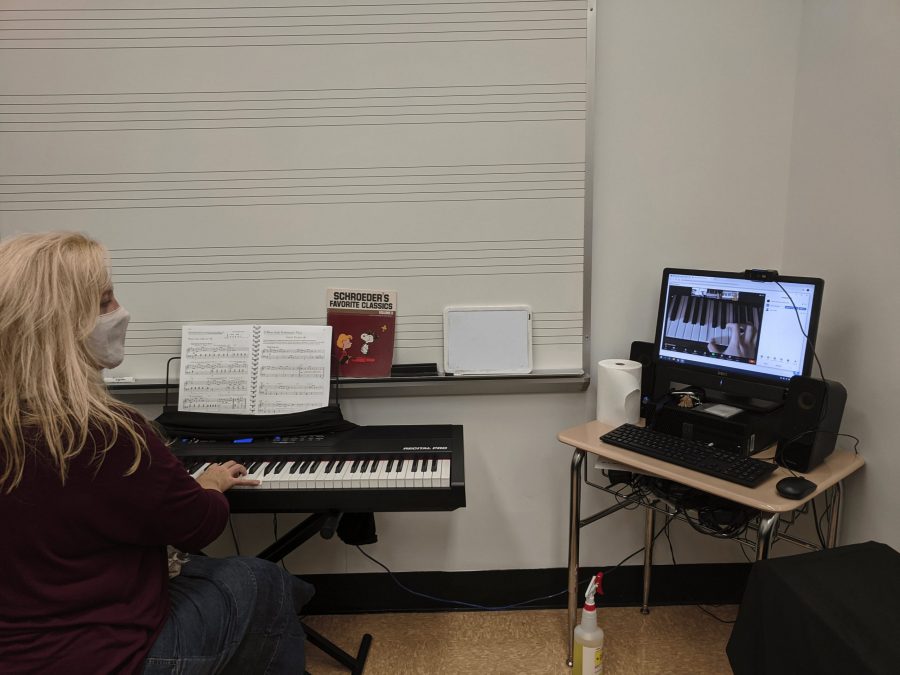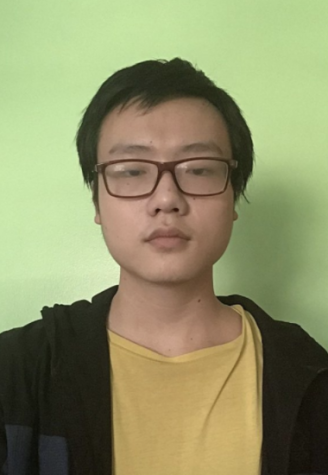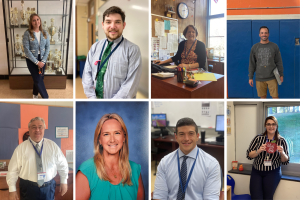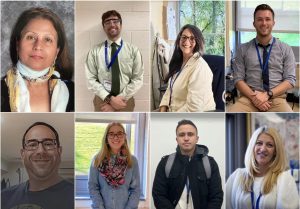Connecting Distance through Harmony
Hands seen through the screen—Dr. Janine Robinson teaches her piano class using a webcam in the piano lab. She is able to demonstrate piano techniques to her students while also viewing their hands on their keyboards.
January 13, 2021
A student sits besides a piano and looks at the space around him. The stage that had once been lined by rows of musicians now holds nothing but scattered and empty stands. The seats that had once sat countless audiences now remain bare and void. Turning his attention back to the piano, the student takes a deep breath. Abruptly, the sound of silence is replaced by a melody. Each tone is smooth and delicate, and each note connects with the one that follows. Voices of passion, rage, and sorrow are harmonized by the music, and the student longs for someone to experience his masterpiece.
Though this may seem like a time of pure isolation at South High, that could not be any further from the truth. While the school year has certainly been different from the past, many teachers have been able to adjust to the new system of learning and have found different ways to run their classes. This holds true especially for the teachers of the Performing Arts, who have made a tremendous number of changes in their courses to adapt to these unusual times.
Dr. Janine Robinson, who teaches piano and vocal music, has made several adjustments to her classes in order to ensure that her students are able to learn safely. The students who attend in-person classes work from individual practice rooms with sanitized keyboards. Remote students attend virtually while sitting by their keyboards or pianos at home. A webcam has been hooked up in the Piano Lab so that students can view proper instrumental techniques that Dr. Robinson demonstrates on her keyboard. “The lessons work pretty normally,” said Dr. Robinson. “Students bring their iPads to where their piano is, and I am able to see their hands on their keyboards as I teach them.”
Mr. Michael Schwartz, chairperson of the Performing Arts Department, has also made several changes to his Chamber Orchestra and String Orchestra classes in order to accommodate the hybrid model. The in-person students wear masks and play seated six feet apart, and the class runs as normal. The fully remote students, however, have a more challenging set up. Not all students at home are able to play along with the students in school because they can not disrupt their siblings who are also attending classes virtually. Moreover, the students who are able to play at home have to mute themselves because of latency. As a result, Mr. Schwartz has invested in a program known as SmartMusic in order to ensure that every student is able to follow along with the curriculum. “SmartMusic gives us the ability to teach both in school and remotely,” said Mr. Schwartz. “Students are able to look at the music assigned to them, and they would be able to practice their parts, which they could then record and be graded on.”
Mr. Anthony Virgilio, who teaches guitar and music technology, takes a similar approach. Like the students in Chamber and String Orchestra classes, the students who attend the guitar classes in school wear masks and play six feet apart. As for fully remote students, Mr. Virgilio shares a screen containing a metronome, and the students at home follow along with the pieces given to them through Google Classroom while staying muted. “The students at home play with the students in school,” said Mr. Virgilio. “I watch their fingering, and I watch where their hands are going and the expressions on their faces in order to see if they’re feeling overwhelmed. I also have them occasionally record themselves playing and upload it to Google Classroom, and that would be a performance assessment.”
The new system of hybrid and remote learning is more complicated in regards to the students of Symphonic Band and Choir. Like the orchestra, guitar, and piano classes, the remote students of the bands and choir classes participate while remaining muted, and they are assessed later through applications such as SmartMusic. However, the situation for the students in school is a bit more complex. Because the band and choir classes use heavy flows of breath, extra precautions must be taken in order to prevent the aerosol spread of the virus. As a result, the students of the band and choir classes were initially not allowed to sing and play. Instead, Mr. Schwartz and Dr. Robinson had their students practice musical techniques without actually playing or singing during the first few weeks of school. The Choir students practiced reading, rhythmically speaking, and deepening musical literacy while the Symphonic Band students looked at pieces assigned to them and fingered their parts rather than playing. Fortunately, the students of Symphonic Band and Choir were soon allowed to sing and play after a few weeks, but they now need to be at a further distance of 12 feet from one another. “Our classroom is large enough for students to remain far apart,” said Dr. Robinson. “We also keep our window open for continuous flow of fresh air.”
Meeting virtually and maintaining social distance is certainly not the ideal way of learning, especially for a program whose purpose is for students to come together and learn face to face. Even so, the students of Performing Arts have demonstrated that they have well adjusted to these new and unusual changes. “When we finally started playing, I was hearing a band,” said Mr. Schwartz. “But we have never actually played together and practiced together beforehand. It shows us that even without being able to actually play, the students have been learning all that they could without their instruments.”






